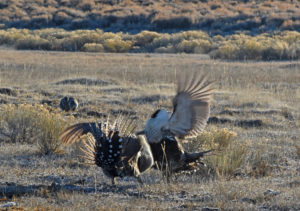For Immediate Release
May 30, 2024
Contacts
Adam Bronstein, Western Watersheds Project, 541-595-8034, adam@westernwatersheds.org
Paul Engelmeyer, Bird Alliance of Oregon, 541-547-4097, pengelmeyer@peak.org
Jess Helsley, Wild Salmon Center, 208-413-1120, jhelsley@wildsalmoncenter.org
Ryan Talbott, WildEarth Guardians, 503-329-9162, rtalbott@wildearthguardians.
Oregon Conservation Coalition Requests Oregon Wildlife Commission Close Federal Lands to Beaver Trapping
SALEM, Ore. — More than forty conservation groups submitted this letter to the Oregon Fish and Wildlife Commission requesting that commissioners vote to close federally managed public lands to beaver trapping and hunting during the June 14 meeting in Chiloquin.
“As it stands, fewer than 200 beaver trappers are depriving 4.2 million Oregonians of the crucial benefits beavers provide; abundant water, natural fire breaks, carbon sequestration, and vastly expanded fish and wildlife habitat on our public lands,” said Adam Bronstein, Oregon Director for Western Watersheds Project. “As a hunter and angler, I am calling on the Commission to fulfill the mission of their organization and do what is best for fish and wildlife habitat in the state on behalf of all of all citizens.”
“Protecting beavers is crucial for threatened salmon populations because their dams create essential habitats that support the growth and survival of young salmon, enhancing biodiversity and ensuring the resilience of aquatic ecosystems,” said Fran Recht, letter co-author. “Regulating beaver trapping and hunting is the only cause of mortality over which we have direct control and our public lands represent the best place where we can reliably recover sensitive fish and wildlife species that depend on beaver created and maintained habitat.”
ODFW has noted that beaver-created habitats can improve conditions for over 50 Oregon Conservation Strategy species.
“The health of both coho salmon and our coastal rainforest rivers are inextricably linked with beavers. There’s a reason why restoration engineers mimic what beavers do naturally: beaver dams and lodges reconnect streams to their floodplains, creating habitat complexity that cools and slows rivers, while creating habitat for juvenile salmon and small invertebrate critters at the base of the food chain,” said Jess Helsley, Director of Watershed Restoration for the Wild Salmon Center. “By helping beavers return to the landscape, we are restoring function to our coastal systems for the communities and coho that depend on them.”
“We are committed to recovery of the many ESA-listed salmon stocks, and robust beaver populations is one key piece of that effort – they will work in upper parts of the watersheds/federal lands for free. We need robust populations at the landscape scale,” said Paul Englemeyer with the Wild Bird Alliance of Oregon. “Working groups and collaborative processes are not addressing the need to quickly build up beaver populations on federal lands so they can help Oregon moderate fire impacts and address the climate and species crisis, and quite frankly, the status-quo is not working.”
“If we want ecosystem resilience, healthy salmon runs, and cooler, cleaner water, this is the obvious step,” said Ryan Talbott, Pacific Northwest Conservation Advocate with WildEarth Guardians. “We need to shift the paradigm from treating beavers as nuisances and pelts to sell, and begin to truly recognize their importance as critical ecosystem engineers.”
A similar request to the Commission to close beaver hunting and trapping on federally managed public lands was submitted by a coalition of Oregon scientists . Their request flags the urgency of climate changes and resulting increases in the severity and frequency of wildfires and droughts, declining fish and wildlife habitat, increased biodiversity losses, increased water conflicts, and declining water security for Oregon communities, all of which robust beaver populations on these public lands would help address.
####






